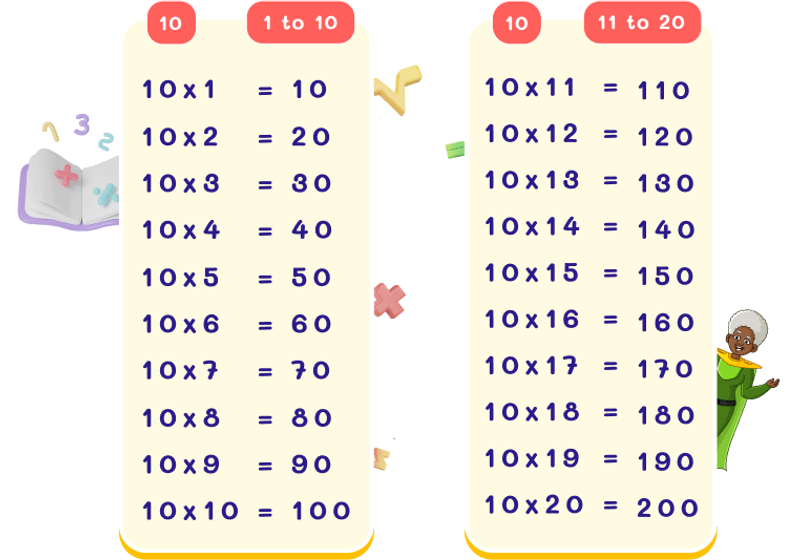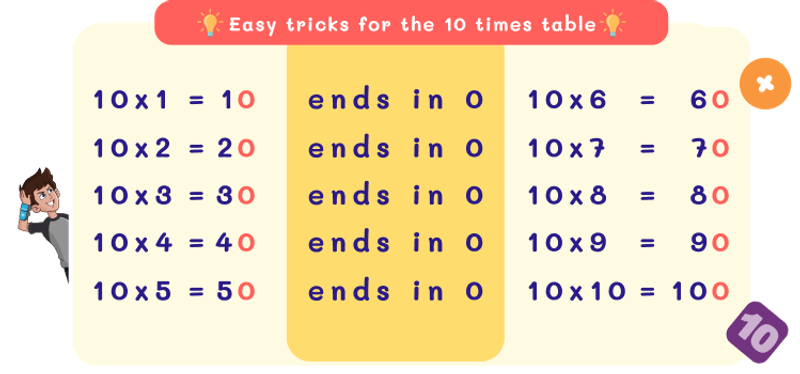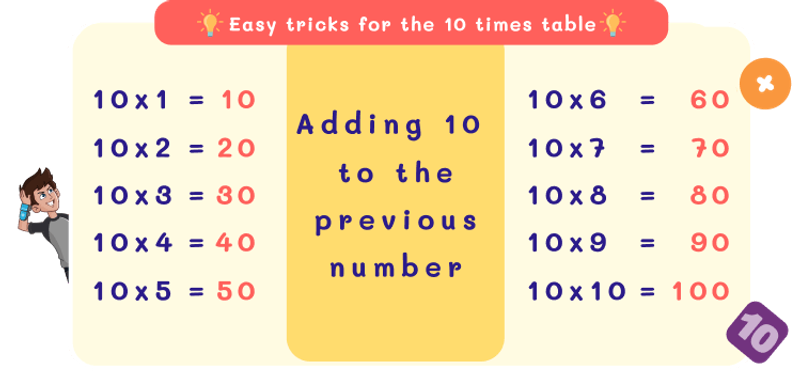
 1455 Learners
1455 LearnersLast updated on May 26th, 2025

10 Times Table

Table of 10 consists of the multiples of the number 10 when multiplied by integers. This table helps in fast multiplication in larger numbers. Below are facts about the table of 10.
What is a Multiplication Table of 10?
The table of 10 is one of the tables with a simple pattern among the multiplication tables.
- Table of 10 consists of multiples of 10, a list with a structure that helps the learner calculate the sums of 10.
- The pattern followed in the table is repeated addition of 10 and keeps increasing as 10, 36, 54, 72, 90, 108, 126, 144, 162, 100…
- The digits at the one’s place of the product of the table of 10 are in the order 8, 6, 4, 2, and 0.
- All the products in Table of 10 are even numbers.
10 Times Table Chart
The table of 10 is simple and can be used to solve other larger multiplication tables. Practicing it regularly helps the learner to understand the pattern.
Here is the table of 10 from the multiples 1 to 10 and 11 to 20.
| TABLE OF 10 (1-10) | |
|---|---|
|
10 x 1 = 10 |
10 x 6 = 60 |
|
10 x 2 = 20 |
10 x 7 = 70 |
|
10 x 3 = 30 |
10 x 8 = 80 |
|
10 x 4 = 40 |
10 x 9 = 90 |
|
10 x 5 = 50 |
10 x 10 = 100 |
| TABLE OF 10 (11-20) | |
|---|---|
|
10 x 11 = 110 |
10 x 16 = 160 |
|
10 x 12 = 120 |
10 x 17 = 170 |
|
10 x 13 = 130 |
10 x 18 = 180 |
|
10 x 14 = 140 |
10 x 19 = 190 |
|
10 x 15 = 150 |
10 x 20 = 200 |
Tips and Tricks for the Multiplication Table of 10
Multiplication tables are fundamental for developing math skills. Some tips and tricks for Table of 10 are listed below.
- Table of 10 has a pattern, 0 is the only number at one’s place and after the multiple 10ten’s place.
- The table of 10 can also be practiced using the skip counting method, i.e., by counting 10s: 10, 20, 30, 40, 50, 60, 70, 80, 90, 100, and so on.
- By adding 0 after the multiple, the products of the table of 10 can be found.
- The table of 10 has a rhythmic pattern, and practicing using that is very effective.

Common Mistakes and How to Avoid Them in 10 Times Tables
While learning the table of 10, it is possible to commit mistakes. You can avoid making these mistakes by being more careful in the area mentioned below.

10 Times Table Examples

Problem 1
There are 10 seats in a van. Find the number of seats in 14 vans?

Number of seats in a van= 10 seats
Number of vans = 14 vans
Total number of seats = Number of seats in a van x Number of vans
10 x 14 = 140.
140 seats.
Explanation
The number of seats in a van multiplied by the number of vans would be the total number of seats, 10 x 14 = 140.

Problem 2
To fill one can 10 liters of water is required. How many liters of water are required to fill 68 cans?

Capacity of one can = 10 liters
Total number of cans = 68 cans
The total liters of water required = The capacity of one can x The Total number of cans
10 x 68 = 680.
680 liters.
Explanation
The capacity of one can be multiplied by the total number of cans would be the total liters of water required, 10 x 68 = 680.

Problem 3
There are 10 apples in a box if there are 44 boxes, how many apples are there in total?

Number of apples in one box = 10 apples
Number of boxes = 44 boxes
Total number of apples = Number of apples in one box x Number of boxes
10 x 44 = 440
440 Apples.
Explanation
The number of apples in one box multiplied by the number of boxes would be The total number of apples. 10 x 44 = 440.


FAQs on 10 Times Table
1.Explain a method to memorize the table of 10.
2.What is the pattern followed by the table of 10?
3.What is 10 times 62? Use the breaking down method.
4.What is 10 times 10000?
5.Can I use the multiplication table of 10 in the division?
6.How can poems help children in Australia memorize the Multiplication Table and 10 Times Table?
7.Can learning the Multiplication Table influence creativity in solving 10 Times Table challenges for kids in Australia?
8.How do language and cultural differences in Australia affect the way children learn the Multiplication Table and 10 Times Table?
9.What role does brain development play in mastering the Multiplication Table and 10 Times Table among early learners in Australia?
Important Glossaries for Multiples of 10
- Factor: Factors are the numbers that can be multiplied to get a product.
- Skip counting: Counting by 10, to get the products quickly.
- Inverse operation: Operations that undo each other.
- Multiple: The number that can be evenly divided by another number.
- Product: The result obtained when multiplication is performed.
- Breaking down: The multiple is broken down into simpler forms.
Explore More multiplication-tables
About BrightChamps in Australia


Seyed Ali Fathima S
About the Author
Seyed Ali Fathima S a math expert with nearly 5 years of experience as a math teacher. From an engineer to a math teacher, shows her passion for math and teaching. She is a calculator queen, who loves tables and she turns tables to puzzles and songs.
Fun Fact
: She has songs for each table which helps her to remember the tables







